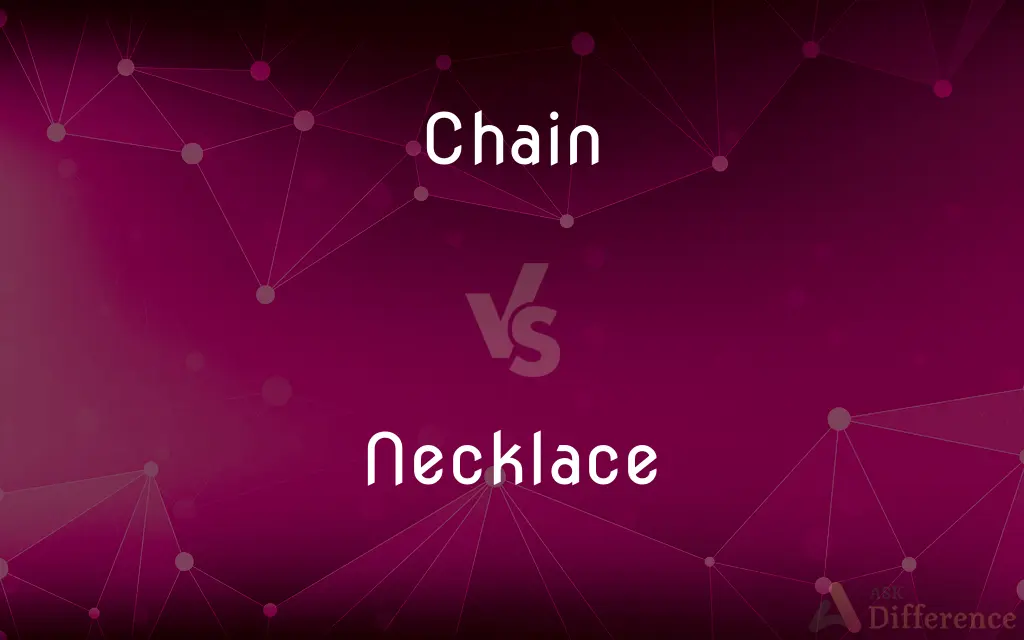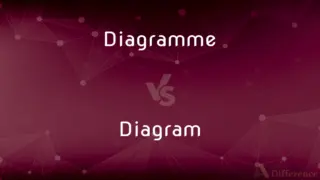Chain vs. Necklace — What's the Difference?
By Tayyaba Rehman & Fiza Rafique — Updated on March 14, 2024
A chain is a series of connected links, often metal, used as jewelry or for functional purposes. A necklace is a piece of jewelry worn around the neck, which can include chains, beads, or pendants.

Difference Between Chain and Necklace
Table of Contents
ADVERTISEMENT
Key Differences
A chain, in its most basic form, consists of a series of connected metal links. It serves various functions, from a fundamental component in jewelry design to practical uses in machinery and securing objects. Conversely, a necklace is a broader term for an adornment worn around the neck, which can be made up of chains, beads, pendants, or other decorative elements. While a chain can be a standalone piece of jewelry, it often acts as a support for pendants and charms when used as part of a necklace.
Chains are characterized by their construction, which can include a variety of link designs such as cable, curb, rope, and box. Each type of link provides a different texture and strength, making some chains more suitable for heavy pendants, while others are delicate and designed for lightweight decoration. Necklaces, on the other hand, focus on the overall aesthetic and symbolic significance, incorporating various materials such as precious metals, gemstones, and even organic materials like pearls and shells.
When considering functionality, chains often offer versatility. A single chain can be worn in different lengths and styles, or layered with other chains for a more complex look. Necklaces, due to their more intricate designs and components, serve as statement pieces and are chosen to complement specific outfits or occasions. They can convey personal meaning, cultural heritage, or artistic expression.
Maintenance and care for chains and necklaces can differ significantly. Simple metal chains might require minimal upkeep, mainly to prevent tarnishing, while necklaces with multiple materials or intricate designs may need careful cleaning and storage to preserve their appearance and integrity.
In terms of fashion and personal style, chains offer a minimalist option, appealing to those who prefer understated elegance or a more masculine look. Necklaces, with their wide range of styles and designs, cater to diverse tastes and occasions, from casual and bohemian to formal and sophisticated.
ADVERTISEMENT
Comparison Chart
Composition
Series of connected metal links
Can include chains, beads, pendants, and other elements
Functionality
Versatile, used in jewelry and practical applications
Primarily decorative, worn around the neck
Design Variability
Various link designs for different textures and strength
Wide range of styles, materials, and symbolic elements
Care and Maintenance
Generally requires minimal upkeep
May need careful cleaning and storage due to complexity
Style and Expression
Minimalist and often more masculine
Diverse, ranging from casual to sophisticated
Compare with Definitions
Chain
A series of connected metal links, used for both decorative and practical purposes.
He wore a simple gold chain around his neck.
Necklace
Often includes chains but can be made with beads, pendants, and more.
The necklace had a large gemstone pendant that caught everyone's eye.
Chain
Offers versatility in wear, often used to support pendants.
She switched out her chains depending on the outfit.
Necklace
May require specific care to maintain materials and design integrity.
The pearl necklace was stored in a silk-lined box to prevent damage.
Chain
Appeals for its understated elegance and simplicity.
The minimalist loved the sleek look of a plain chain.
Necklace
Serves as a statement piece, chosen for specific occasions.
For the gala, she chose an elaborate diamond necklace.
Chain
Can feature various types of link designs like cable, curb, or rope.
The delicate box chain was perfect for her small pendant.
Necklace
A decorative piece worn around the neck, featuring a variety of materials and designs.
Her necklace with colorful beads was a statement piece.
Chain
Requires minimal maintenance, mostly to avoid tarnishing.
He polished his silver chain to restore its shine.
Necklace
Reflects personal style, ranging from bohemian to formal.
Her bohemian necklace complemented her free-spirited fashion sense.
Chain
A chain is a serial assembly of connected pieces, called links, typically made of metal, with an overall character similar to that of a rope in that it is flexible and curved in compression but linear, rigid, and load-bearing in tension. A chain may consist of two or more links.
Necklace
A necklace is an article of jewellery that is worn around the neck. Necklaces may have been one of the earliest types of adornment worn by humans.
Chain
A series of linked metal rings used for fastening or securing something, or for pulling loads
The drug dealer is being kept in chains
He slid the bolts on the front door and put the safety chain across
Necklace
An ornamental chain or string of beads, jewels, or links worn round the neck
The harbour with its necklace of lights
A diamond necklace
Chain
A sequence of items of the same type forming a line
He kept the chain of buckets supplied with water
Necklace
(in South Africa) a tyre doused or filled with petrol, placed round a victim's neck and set alight.
Chain
A jointed measuring line consisting of linked metal rods.
Necklace
(in South Africa) kill (someone) with a tyre necklace.
Chain
A structure of planks projecting horizontally from a sailing ship's sides abreast of the masts, used to widen the basis for the shrouds.
Necklace
An ornament worn around the neck.
Chain
Fasten or secure with a chain
She chained her bicycle to the railings
Necklace
Something felt to resemble this neck ornament, as in shape
A necklace of hundreds of tiny islands.
Chain
A connected, flexible series of links, typically of metal, used especially for holding objects together, for restraining, or for transmitting mechanical power.
Necklace
An article of jewelry that is worn around the neck, most often made of a string of precious metal, pearls, gems, beads or shells, and sometimes having a pendant attached.
Chain
Such a set of links, often of precious metal and with pendants attached, worn as an ornament or symbol of office.
Necklace
(figuratively) Anything resembling a necklace in shape.
A necklace of coral islands
Chain
Often chains(Football) Such a set of links measuring ten yards and attached to a pole at each end, moved up and down the field to indicate necessary yardage for gaining a first down.
Necklace
(South Africa) A device used in necklacing (an informal execution); a rubber tyre that is filled with petrol. It is placed around the victim's chest and arms, and set on fire.
Chain
A restraining or confining agent or force.
Necklace
(South Africa) To informally execute by necklacing; by setting on fire a petrol-filled rubber tyre which has been put around the bound victim's neck.
Chain
Bonds, fetters, or shackles.
Necklace
A string of beads, etc., or any continuous band or chain, worn around the neck as an ornament.
Chain
Captivity or oppression; bondage
Threw off the chains of slavery.
Necklace
A rope or chain fitted around the masthead to hold hanging blocks for jibs and stays.
Chain
A series of closely linked or connected things
A chain of coincidences.
Necklace
Jewelry consisting of a cord or chain (often bearing gems) worn about the neck as an ornament (especially by women)
Chain
A number of establishments, such as stores, theaters, or hotels, under common ownership or management.
Chain
A range of mountains.
Chain
(Chemistry) A series of chemically bonded atoms, especially carbon atoms, which may be arranged in an open, branched, or cyclic structure.
Chain
An instrument used in surveying, consisting of 100 linked pieces of iron or steel and measuring 66 feet (20.1 meters). Also called Gunter's chain.
Chain
A similar instrument used in engineering, measuring 100 feet (30.5 meters).
Chain
Abbr. ch A unit of measurement equal to the length of either of these instruments.
Chain
To bind or make fast with a chain or chains
Chained the dog to a tree.
Chain
To restrain or confine as if with chains
Workers who were chained to a life of dull routine.
Chain
A series of interconnected rings or links usually made of metal.
He wore a gold chain around the neck.
The anchor is connected to the boat with a 100-metre long chain.
Chain
A series of interconnected things.
A chain of mountains
A chain of ideas, one leading to the next
This led to an unfortunate chain of events.
Chain
A series of stores or businesses with the same brand name.
That chain of restaurants is expanding into our town.
Chain
(chemistry) A number of atoms in a series, which combine to form a molecule.
When examined, the molecular chain included oxygen and hydrogen.
Chain
(surveying) A series of interconnected links of known length, used as a measuring device.
Chain
(surveying) A long measuring tape.
Chain
A unit of length equal to 22 yards. The length of a Gunter's surveying chain. The length of a cricket pitch. Equal to 20.12 metres, 4 rods, or 100 links.
Chain
A totally ordered set, especially a totally ordered subset of a poset.
Chain
(British) A sequence of linked house purchases, each of which is dependent on the preceding and succeeding purchase (said to be "broken" if a buyer or seller pulls out).
Chain
That which confines, fetters, or secures; a bond.
The chains of habit
Chain
Iron links bolted to the side of a vessel to bold the dead-eyes connected with the shrouds; also, the channels.
Chain
A livery collar, a chain of office.
Chain
(weaving) The warp threads of a web.
Chain
(transitive) To fasten something with a chain.
You should chain your bicycle to the railings to protect it from being stolen.
Chain
(figurative) To connect as if with a chain, due to dependence, addiction, or other feelings
Sometimes I feel like I'm chained to this computer.
She's been chained to her principles since she was 18, it's unlikely you can convince her otherwise.
Chain
(intransitive) To link multiple items together.
Chain
(transitive) To secure someone with fetters.
Chain
(transitive) To obstruct the mouth of a river etc with a chain.
Chain
(figurative) To obligate.
Chain
(computing) To relate data items with a chain of pointers.
Chain
(computing) To be chained to another data item.
Chain
(transitive) To measure a distance using a 66-foot long chain, as in land surveying.
Chain
To load and automatically run (a program).
Chain
A series of links or rings, usually of metal, connected, or fitted into one another, used for various purposes, as of support, of restraint, of ornament, of the exertion and transmission of mechanical power, etc.
[They] put a chain of gold about his neck.
Chain
That which confines, fetters, or secures, as a chain; a bond; as, the chains of habit.
Driven downTo chains of darkness and the undying worm.
Chain
A series of things linked together; or a series of things connected and following each other in succession; as, a chain of mountains; a chain of events or ideas.
Chain
An instrument which consists of links and is used in measuring land.
Chain
Iron links bolted to the side of a vessel to bold the dead-eyes connected with the shrouds; also, the channels.
Chain
The warp threads of a web.
Chain
To fasten, bind, or connect with a chain; to fasten or bind securely, as with a chain; as, to chain a bulldog.
Chained behind the hostile car.
Chain
To keep in slavery; to enslave.
And which more blest? who chained his country, sayOr he whose virtue sighed to lose a day?
Chain
To unite closely and strongly.
And in this vow do chain my soul to thine.
Chain
To measure with the chain.
Chain
To protect by drawing a chain across, as a harbor.
Chain
A series of things depending on each other as if linked together;
The chain of command
A complicated concatenation of circumstances
Chain
(chemistry) a series of linked atoms (generally in an organic molecule)
Chain
A series of (usually metal) rings or links fitted into one another to make a flexible ligament
Chain
A number of similar establishments (stores or restaurants or banks or hotels or theaters) under one ownership
Chain
Anything that acts as a restraint
Chain
A unit of length
Chain
British biochemist (born in Germany) who isolated and purified penicillin, which had been discovered in 1928 by Sir Alexander Fleming (1906-1979)
Chain
A series of hills or mountains;
The valley was between two ranges of hills
The plains lay just beyond the mountain range
Chain
Metal shackles; for hands or legs
Chain
A necklace made by a stringing objects together;
A string of beads
A strand of pearls
Chain
Connect or arrange into a chain by linking
Chain
Fasten or secure with chains;
Chain the chairs together
Common Curiosities
What makes a necklace different from a simple chain?
A necklace differs from a simple chain in its complexity and design, often incorporating beads, pendants, and various materials beyond just metal links.
Are all necklaces made with chains?
Not all necklaces are made with chains; some use cords, beads, or other materials as their base.
Can a chain be considered a necklace?
Yes, a chain can be considered a necklace when worn around the neck as a piece of jewelry.
How do I choose between a chain and a necklace?
The choice between a chain and a necklace depends on personal style, the occasion, and whether you prefer simplicity or a statement piece.
Are chain designs gender-specific?
While some chain designs may be marketed towards specific genders, many styles are universally appealing and worn by anyone.
How do I know if a chain is strong enough for my pendant?
The strength of a chain for a pendant depends on the chain's design and the weight of the pendant; thicker, more robust link designs are better for heavier pendants.
How do link designs affect a chain's appearance?
The design of the links can affect a chain's flexibility, texture, and overall appearance, making each style unique.
What type of necklace is best for formal events?
For formal events, necklaces with precious metals and stones, like diamonds or pearls, are often chosen for their elegance and sophistication.
Can chains and necklaces be layered together?
Yes, chains and necklaces can be layered together for a more dynamic and personalized look.
Can a necklace have multiple chains?
Yes, a necklace can have multiple chains as part of its design, adding texture and complexity.
What is the significance of wearing a necklace?
Necklaces can have personal, cultural, or fashion significance, ranging from symbolizing important relationships to expressing individual style.
What is the best way to clean a chain or necklace?
The best cleaning method depends on the materials; metal chains often need only polishing, while necklaces with diverse elements may require gentle cleaning solutions and careful handling.
Is there a trend in choosing chains over necklaces or vice versa?
Trends in jewelry vary widely, with some periods favoring the simplicity of chains and others the intricacy of necklaces, often influenced by broader fashion trends.
Can I customize my own necklace?
Yes, many jewelers offer customization options, allowing you to select the chain, pendants, and other elements for a personalized necklace.
What are some common materials used in necklaces?
Common materials for necklaces include gold, silver, platinum, beads, gemstones, pearls, and even organic materials like leather and feathers.
Share Your Discovery

Previous Comparison
Hospitalised vs. Hospitalized
Next Comparison
Diagramme vs. DiagramAuthor Spotlight
Written by
Tayyaba RehmanTayyaba Rehman is a distinguished writer, currently serving as a primary contributor to askdifference.com. As a researcher in semantics and etymology, Tayyaba's passion for the complexity of languages and their distinctions has found a perfect home on the platform. Tayyaba delves into the intricacies of language, distinguishing between commonly confused words and phrases, thereby providing clarity for readers worldwide.
Co-written by
Fiza RafiqueFiza Rafique is a skilled content writer at AskDifference.com, where she meticulously refines and enhances written pieces. Drawing from her vast editorial expertise, Fiza ensures clarity, accuracy, and precision in every article. Passionate about language, she continually seeks to elevate the quality of content for readers worldwide.















































